

If that occurs, then at an annual meeting by the WMO committee (called primarily to discuss many other issues) Of its name on a different storm would be inappropriate for reasons of sensitivity. The only time that there is a change in the list is if a storm is so deadly or costly that the future use Thus, the 2004 list was used again in 20. The lists featured only women's names until 1979, when men's and women's names were alternated. Since 1953, Atlantic tropical storms have been named from lists originated by the National Hurricane Center and now maintained and updated by an international committee of the World Meteorological Organization (WMO). Hurricane Ivan 2004 (Cat5) in the Caribbean, north of South America In the past, confusion and false rumors have arisen when storm advisories broadcast from radio stations were mistaken for warning concerning an entirely different storm located hundreds of miles away. The use of easily remembered names greatly reduces confusion when two or more tropical storms occur at the same time.įor example, one hurricane can be moving slowly westward in the Gulf of Mexico, while at exactly the same time another hurricane can be moving rapidly northward along the Atlantic coast. These advantages are especially important in exchanging detailed storm information between hundreds of widely scattered stations, coastal bases, and ships at sea. Temperature trends in the Midwest show an overall warming of between 0.3˚F to 1.8˚F from data collected during the period of 1895-2006.(NOTE: We have updated this article and re-published.Įxperience shows that the use of short, distinctive given names in written as well as spoken communications is quicker and less subject to error than the older more cumbersome latitude-longitude identification methods. The climate however, is a trend over an extended period of time. Winter temperatures can vary just as much. Some days can be very warm, with record temperatures over 100˚Fahrenheit (F), with other summer days not even reaching 70˚F.

Build background by providing the following example: The weather in Wisconsin can vary from day to day. Climate is an average pattern of weather for a particular region. The term climate describes weather patterns of a particular region over a longer period, usually 30 years or more. Make sure students understand that the term weather describes conditions in the atmosphere over a short period of time. Have students make connections between weather and climate.Īsk: What is climate? How does climate relate to weather? Some students may understand that the climate in areas closer to the Equator has fewer extremes than in the areas farther away from the Equator. The impact of solar flare X-rays on the Earths ionosphere causes a prompt loss of. These eruptions are announced by an immediate burst of electromagnetic radiation, including X-rays and ultraviolet light, called a solar flare. Hail storm: cold or warm temperatures, rain, iceĪfter students have completed the worksheet, ask: What patterns do you see?Ĥ. The largest space weather events are caused when the Sun experiences a giant magnetic eruption from a sunspot region.Dust storm: strong winds, arid conditions.Blizzard: heavy snow, ice, cold temperatures.Hurricane or cyclone: strong wind, heavy rain.Tornado: clouds, strong wind, rain, hail.The word storm doesnt begin to describe what happened in this Chinese city. Their answers should include the following: EXAMPLES OF EXTREME WEATHER EVENTS The Zhengzhou storm. Allow students to gather and organize the information they have learned about weather and atmospheric conditions present for each type of weather. Read aloud the directions and go over the provided answer. Have students complete the worksheet Weather Investigation.ĭistribute a copy of the worksheet Weather Investigation to each student. Ask: What are the factors that affect extreme weather? Elicit responses from students such as: the sun ( temperature), water ( precipitation), and other atmospheric conditions like jet stream, pressure, wind, humidity, and clouds.ģ. Then ask: What are the necessary conditions for each weather event to occur? Elicit responses from students such as: differences in circulating air masses, clashing warm and cool air masses ( fronts), and jet streams. Then, show the National Geographic video “Weather 101.” Ask students to describe the extreme weather events. Invite volunteers to read aloud each caption. Display the photo gallery Extreme Weather. Tell students they will look at a photo gallery of extreme weather and then watch a video about weather. Discuss a photo gallery of extreme weather. Then ask students to sort the list into logical categories, such as types of weather, tools to measure weather, and effects of weather.Ģ. Activate students’ prior knowledge about extreme weather on Earth.Īsk: What do you know about extreme weather on Earth? Have students brainstorm a list of weather-related words and phrases.


 0 kommentar(er)
0 kommentar(er)
